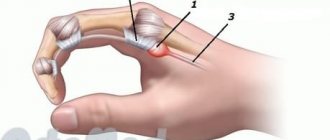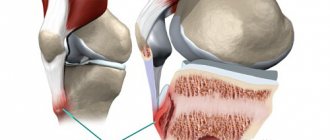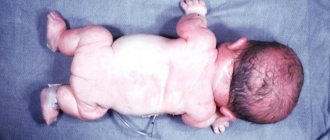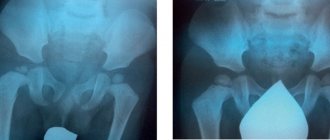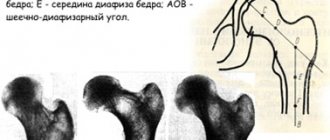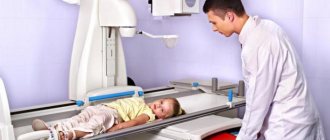Fibrous dysplasia is a very serious pathology of bone tissue with partial replacement of it by connective fibers. Naturally, scar tissue does not have the properties of bone. Therefore, there is a violation of integrity, numerous fractures in the area of the replacement foci. With total destruction of the bone, its curvature can form.
Fibrous bone dysplasia mainly affects children and adolescents. This is due to the fact that the pathological changes are based on intrauterine developmental disorders. Primary signs can develop in the presence of associated risk factors. A sedentary lifestyle, insufficient development of muscle tissue of the lower extremities, nutritional deficiency of certain vitamins and minerals - all this is a trigger for the development of fibrous dysplasia of the leg bones.
It is important to understand that the disease, although in most cases has a congenital etiology, is easily correctable and preventable. Fibrous dysplasia of the leg often affects the long tubular bones: the femur, fibula, and tibia. With total destruction, a polyostotic form can be identified. The monoosal form is the localization of single foci of fibrous replacement of bone tissue in the cavity of one bone. Rarely does a two-way transformation occur. Usually only one limb is affected.
If you suspect that you or your child have such changes, we advise you to immediately seek medical help. To do this, you can make an appointment for a free appointment at our manual therapy clinic. An experienced orthopedist will conduct a thorough examination. He will make a diagnosis and tell you how treatment can be carried out to stop the pathological process and return the normal state of bone tissue.
Causes of fibrous dysplasia
Knowing the causes of fibrous bone dysplasia is necessary in order to be able to exclude them and thus carry out effective prevention of the disease.
You should start with exposure factors at the stage of intrauterine development. A high risk of developing pathology in the fetus may occur if a woman during pregnancy:
- did not follow the doctor’s recommendations;
- did not take vitamin-mineral complexes;
- used hormonal medications as prescribed by a doctor to maintain pregnancy;
- suffered from acute viral and bacterial infections;
- was treated with antibacterial and antiviral agents.
After birth, the following triad of negative factors comes into play:
- lack of sufficient care for the baby, including massage, gymnastics, air baths;
- vitamin D deficiency, leading to the launch of the process of destruction of bone tissue against the background of rickets;
- decreased level of immune defense in the absence of a long period of breastfeeding.
Thus, we can conclude that the risk group for developing fibrous dysplasia of the leg bones includes infants from socially disadvantaged families, premature babies and those who are bottle-fed. Prevention of rickets is important, especially in northern regions where there is a shortage of sunny days.
At the age of over 3 years, risk factors for the development of dysplasia are supplemented by a deficiency of certain elements in the daily diet. It is known that children of toddler and preschool age are particularly picky in choosing foods for their diet. For the most part, they categorically refuse milk and dairy products. This leads to inevitable calcium deficiency. Total destruction of tooth enamel begins. Following persistent and invincible caries comes bone dysplasia. Calcium is washed out of it in large quantities. In conditions of total deficiency of this microelement in the blood, the lesions are replaced by fibrous connective fibers.
Thus, if your child aged 4–7 years has a serious problem with his teeth, you constantly visit the dentist and still this does not help cure caries, you should not think that the baby just eats a lot of sweets. Most likely he has a calcium deficiency. We urgently need to do a biochemical blood test to determine this microelement. If a deficiency is indeed present, then it is important to carry out specific prevention and look for the cause of the pathology.
In an adult, fibrous dysplasia of the leg bones can be caused by the following pathologies:
- osteoporosis, including those caused by hormonal disorders and intestinal diseases;
- excess body weight with increased physical stress on the periosteum, which loses its ability to provide blood supply to the bone;
- incorrect foot placement;
- sedentary lifestyle and predominantly sedentary work;
- total dystrophy of the sciatic nerve against the background of long-term osteochondrosis of the lumbosacral spine with impaired innervation of all tissues of the lower limb on one or both sides;
- endocrine diseases of the adrenal glands and thyroid gland;
- destruction of large joints of the lower limb and, as a result, weakening of the muscle tissue that ensures normal blood supply.
Connective tissue dysplasia
- last name, first name, patronymic of the subject of personal data;
- Date of Birth;
- place of residence (region/city);
- Mobile phone number;
- email address (e-mail);
- history of requests and views on the Site and its services (for Site visitors);
- other information (the given list may be shortened or expanded depending on the specific case and purposes of processing).
3.3.
The operator ensures that the content and volume of the processed personal data corresponds to the stated purposes of processing and, if necessary, takes measures to eliminate their redundancy in relation to the stated purposes of processing.
3.4.
The operator processes biometric personal data subject to the written consent of the relevant subjects of personal data, as well as in other cases provided for by the legislation of the Russian Federation.
3.5.
The Operator does not process special categories of personal data relating to race, nationality, political views, religious or philosophical beliefs.
3.6.
The Operator does not carry out cross-border transfer of personal data.
Purposes of collecting personal data
4.1. Personal data is processed by the Operator for the following purposes:
- ensuring the organization of medical care to the population, as well as the most complete fulfillment of obligations and competencies in accordance with Federal Laws of November 21, 2011 No. 323-FZ “On the fundamentals of protecting the health of citizens of the Russian Federation”, dated April 12, 2010 No. 61-FZ “On circulation of medicines”, Rules for the provision of paid medical services by medical organizations, approved by Decree of the Government of the Russian Federation of October 4, 2012 No. 1006;
- implementation of labor relations;
- implementation of civil law relations.
- organization and implementation of a set of measures aimed at maintaining and (or) restoring health and including the provision of medical services, including prevention, diagnosis and treatment of diseases;
- implementation of remote interaction of LLC “Clinic of Immunology and Allergology No. 1” with patients and other interested parties within the framework of service and information services through the use of telephone communications, instant messaging services, IP telephony, email
- implementation of remote interaction of LLC “Clinic of Immunology and Allergology No. 1” with patients and other interested parties through the website of LLC “Clinic of Immunology and Allergology No. 1” on the Internet;
- organizing and conducting events aimed at increasing awareness and loyalty towards LLC “Clinic of Immunology and Allergology No. 1”, as well as promotion;
- conducting contractual work not related to the main activities of LLC “Clinic of Immunology and Allergology No. 1”,
- within the framework of the emergence, change and termination of legal relations between LLC “Clinic of Immunology and Allergology No. 1” and third parties, as well as the execution of powers of attorney to represent the interests of the Operator;
- participation of LLC “Clinic of Immunology and Allergology No. 1” in civil, arbitration, criminal, administrative processes and execution of judicial acts;
- filling vacant positions in LLC “Clinic of Immunology and Allergology No. 1” with applicants who most fully meet the Operator’s requirements;
- compliance by LLC "Clinic of Immunology and Allergology No. 1" with the requirements of labor legislation, legislation on labor accounting and remuneration
- preserving the life and health of employees of LLC "Clinic of Immunology and Allergology No. 1" during their work activities and identifying health problems and medical contraindications to work among employees of LLC "Clinic of Immunology and Allergology No. 1" (including examination for medical contraindications to driving a vehicle ), as well as compliance with the requirements of current legislation for the investigation and recording of accidents that occurred with employees of LLC “Clinic of Immunology and Allergology No. 1”;
- implementation of LLC "Clinic of Immunology and Allergology No. 1" as an employer of the responsibilities provided for by the Labor Code of the Russian Federation to pay employees due wages, compensation and bonuses, to make pension and tax contributions, as well as settlements with contractors and patients;
- organizing training, advanced training and knowledge testing for employees of Clinic of Immunology and Allergology No. 1 LLC, assessing the business and personal qualities of employees of Clinic of Immunology and Allergology No. 1 LLC and the results of their work, as well as assessing the satisfaction of employees of Clinic LLC immunology and allergology No. 1” with their work;
- registration of travel documents for employees of Clinic of Immunology and Allergology No. 1 LLC, as well as booking and purchasing hotel rooms and transport tickets in the interests of employees of Clinic of Immunology and Allergology No. 1 LLC sent on business trips;
- facilitating communications between employees of LLC “Clinic of Immunology and Allergology No. 1” by maintaining a directory of contact information for employees of LLC “Clinic of Immunology and Allergology No. 1”;
- ensuring the personal safety of employees of Clinic of Immunology and Allergology No. 1 LLC, other persons visiting real estate (premises, buildings, territory) of Clinic of Immunology and Allergology No. 1 LLC, as well as ensuring the safety of material and other assets managed by the LLC “Clinic of Immunology and Allergology No. 1”;
- allocation/connection of computing resources, creation of new users in the information systems of LLC "Clinic of Immunology and Allergology No. 1", providing access to the resources of information systems of LLC "Clinic of Immunology and Allergology No. 1", as well as solving problems that arise for users in the process of working with computers (hardware and software) and office equipment;
- recording information on the use of corporate landline and mobile communication services by employees of LLC “Clinic of Immunology and Allergology No. 1”;
- conducting an independent audit of the accounting (financial) statements of LLC “Clinic of Immunology and Allergology No. 1” in order to express an opinion on the reliability of such statements;
- organization and implementation of internal quality control of medical care and internal production processes at LLC “Clinic of Immunology and Allergology No. 1”;
- conclusion of any contracts with subjects of personal data and their further execution;
- Conducting promotions, surveys, interviews, testing and research on the Sites by the Operator;
- providing personal data subjects with the Operator’s services, as well as information about new services, including advertising ones;
- feedback from subjects of personal data, including processing of their requests and appeals, informing about the operation of the Site;
- monitoring and improving the quality of the Operator’s services, including those offered on the Site;
- maintaining personnel work and organizing records of the Operator’s employees, regulating labor and other relations directly related to them;
- generation of statistical reporting;
- carrying out economic activities;
- implementation of other functions, powers and duties assigned to the Operator by the legislation of the Russian Federation.
Legal grounds for processing personal data
5.1. The legal grounds for the processing of personal data by the Operator are:
- Constitution of the Russian Federation;
- Labor Code of the Russian Federation dated December 30, 2001 No. 197-FZ;
- Code of the Russian Federation on Administrative Offenses dated December 30, 2001 No. 195-FZ;
- Federal Law of November 21, 2011 No. 323-FZ “On the protection of the health of citizens in the Russian Federation”;
- Federal Law of July 27, 2006 No. 149-FZ “On information, information technologies and information protection”;
- Federal Law of July 27, 2006 No. 152-FZ “On Personal Data”;
- Requirements for the protection of personal data during their processing in personal data information systems (approved by Decree of the Government of the Russian Federation of November 1, 2012 No. 1119);
- Regulations on the specifics of processing personal data carried out without the use of automation tools (approved by Decree of the Government of the Russian Federation of September 15, 2008 No. 687);
- Administrative Regulations of the Federal Service for Supervision in the Sphere of Communications, Information Technologies and Mass Communications for the implementation of the state function “Maintaining a register of operators processing personal data” (approved by Order of the Ministry of Communications and Mass Media of the Russian Federation dated December 21, 2011 No. 346);
- Administrative regulations for the execution by the Federal Service for Supervision in the Sphere of Communications, Information Technologies and Mass Communications of the state function of exercising state control (supervision) over the compliance of the processing of personal data with the requirements of the legislation of the Russian Federation in the field of personal data (approved by Order of the Ministry of Communications and Mass Media of the Russian Federation dated 11/14/2011 No. 312);
- The composition and content of organizational and technical measures to ensure the security of personal data during their processing in personal data information systems (approved by Order of the Federal Service for Technical and Export Control of the Russian Federation dated February 18, 2013 No. 21);
- The composition and content of organizational and technical measures to ensure the security of personal data during their processing in personal data information systems using cryptographic information protection tools necessary to fulfill the requirements established by the Government of the Russian Federation for the protection of personal data for each level of security (approved by the Order of the Federal Service Security of the Russian Federation dated July 10, 2014 No. 378).
- statutory documents of the Operator;
- agreements concluded between the Operator and subjects of personal data;
- consent of personal data subjects to the processing of personal data;
- other grounds when consent to the processing of personal data is not required by law.
Procedure and conditions for processing personal data
6.1. The processing of personal data by the Operator is carried out in the following ways:
- non-automated processing of personal data;
- automated processing of personal data with or without transmission of received information via information and telecommunication networks;
- mixed processing of personal data.
6.2.
List of actions performed by the Operator with personal data: collection, systematization, accumulation, storage, clarification (updating, changing), use, distribution (including transfer), depersonalization, blocking, destruction, as well as carrying out any other actions in accordance with the current legislation of the Russian Federation.
6.3.
The processing of personal data is carried out by the Operator subject to obtaining the consent of the subject of personal data (hereinafter referred to as Consent), with the exception of cases established by the legislation of the Russian Federation when the processing of personal data can be carried out without such Consent.
6.4.
The subject of personal data decides to provide his personal data and gives Consent freely, of his own free will and in his own interest.
6.5.
Consent is given in any form that allows you to confirm the fact of its receipt. In cases provided for by the legislation of the Russian Federation, Consent is issued in writing.
6.6.
The condition for terminating the processing of personal data may be the achievement of the purposes of processing personal data, the expiration of the Consent or withdrawal of Consent by the subject of personal data, as well as the identification of unlawful processing of personal data.
6.7.
Consent may be revoked by written notice sent to the Operator by registered mail.
6.8.
When processing personal data, the operator takes or ensures the adoption of the necessary legal, organizational and technical measures to protect personal data from unauthorized or accidental access to it, destruction, modification, blocking, copying, provision, distribution of personal data, as well as from other unlawful actions in relation to personal data.
6.9.
The storage of personal data is carried out in a form that makes it possible to identify the subject of personal data for a period no longer than required by the purposes of processing personal data, except in cases where the period for storing personal data is established by federal law, an agreement to which a party, beneficiary or guarantor, under which is the subject of personal data.
6.10. When storing personal data, the Operator uses databases located on the territory of the Russian Federation.
Updating, correction, deletion and destruction of personal data, responses to requests from personal data subjects for access to personal data
7.1.
If the fact of inaccuracy of personal data or the illegality of their processing is confirmed, the personal data must be updated by the Operator, or their processing must be stopped accordingly.
7.2.
The fact of inaccuracy of personal data or illegality of their processing can be established either by the subject of personal data or by the competent government bodies of the Russian Federation.
7.3.
At the written request of the subject of personal data or his representative, the Operator is obliged to provide information about the processing of personal data of the specified subject by him. The request must contain the number of the main document identifying the subject of personal data and his representative, information about the date of issue of the specified document and the issuing authority, information confirming the participation of the subject of personal data in relations with the Operator (contract number, date of conclusion of the contract, conventional verbal designation and (or) other information), or information otherwise confirming the fact of processing of personal data by the Operator, signature of the subject of personal data or his representative. The request can be sent in the form of an electronic document and signed with an electronic signature in accordance with the legislation of the Russian Federation.
7.4.
If the request of the personal data subject does not reflect all the necessary information or the subject does not have access rights to the requested information, then a reasoned refusal is sent to him.
7.5.
In the manner provided for in clause 7.3, the subject of personal data has the right to demand that the Operator clarify his personal data, block it or destroy it if the personal data is incomplete, outdated, inaccurate, illegally obtained or is not necessary for the stated purpose of processing, as well as take measures provided by law to protect your rights.
7.6.
When the goals of processing personal data are achieved, as well as in the event that the subject of personal data withdraws Consent, personal data is subject to destruction if:
- The operator has no right to carry out processing without the Consent of the subject of personal data;
- otherwise is not provided for by the agreement to which the subject of personal data is a party, beneficiary or guarantor;
- otherwise is not provided for in another agreement between the Operator and the subject of personal data.
Collection of personal data using the site
8.1.
The website of Clinic of Immunology and Allergology No. 1 LLC uses “cookies” and collects the following information about visitors in order to improve the site: IP address of the visitor, date and time of visiting the site, types of browser and operating system, type and model of mobile device.
8.2.
When using electronic services and providing personal data through the website of Clinic of Immunology and Allergology No. 1 LLC, the user’s information will not be used by Clinic of Immunology and Allergology No. 1 LLC for any other purposes other than to meet his specific needs.
8.3.
By using this site and/or providing LLC “Clinic of Immunology and Allergology No. 1” with his personal data, the site user agrees to the processing of his personal data under the conditions provided for in this Policy.
8.4.
In case of disagreement with this Policy, the user should not use this site and provide LLC “Clinic of Immunology and Allergology No. 1” with his personal data.
Final provisions
9.1.
All relations relating to the processing of personal data that are not reflected in this Policy are regulated in accordance with the provisions of the legislation of the Russian Federation.
9.2.
The operator has the right to make changes to this Policy. When changes are made to the current edition, the date of the last update is indicated. The new edition of the Policy comes into force from the moment it is posted on the Site, unless otherwise provided by the new edition of the Policy.
9.3.
This Policy is subject to publication on the official website https:// https://smartclinic59.ru//. The current version of the Policy on paper is stored at the address: 614000, Perm region, Perm, st. Pushkina, 6.
Fibrous dysplasia of the femur (hip)
Fibrous dysplasia of the femur can be congenital or acquired, single or multifocal, cystic or simple. The form of the pathology depends on the age of the patient. Multifocal fibrocystic fibrodysplasia occurs in elderly patients due to hormonal osteoporosis.
In children under 3 years of age, fibrous dysplasia of the hip most often manifests itself in the form of total replacement of bone tissue trabeculae with connective tissue scars. Curvature of the limb quickly occurs with a decrease in its length. Independent movement is impossible. Numerous fractures are recorded, the site of which does not heal in a typical manner through the formation of a bone callus.
In children aged 3 to 7-8 years, such a pathology can be the result of a gross violation of the diet and stress placed on the lower extremities. Recently, the so-called hypodynamic form of dysplasia has become widespread. It is worth understanding that for proper blood supply to the periosteum, good coordinated work of the muscles of the reed and lower leg is required. Well-trained muscles stimulate capillary blood supply and accelerate metabolic processes in bone tissue. If there is no regular and adequate physical activity on the lower extremities, then bone tissue may begin to deteriorate. In areas of dystrophic changes, scarring occurs with connective tissue.
Fibrous dysplasia of the hip is characterized by a rapidly progressive course. If your child has complaints of pain in the femur, hip or knee joint, immediately contact an experienced orthopedist. The doctor will prescribe treatment that will stop the progression of the dangerous pathology.
Fibrous dysplasia is a disease characterized by a developmental disorder (dysplasia) of the skeleton, in which normal bone is replaced by fibrous tissue with elements of dysplastic bone. There are monoostotic (about 85% of cases), monomelic (several adjacent bones of one limb, shoulder or pelvic girdle are affected) and polyostotic (about 5% of cases) forms. Fibrous dysplasia as a developmental anomaly is sometimes combined with extraskeletal disorders: 1) the polyostotic form of the lesion is combined with premature puberty and pigment spots on the skin in the form of coffee spots (Albright's syndrome); 2) a combination of fibrous dysplasia with soft tissue myxomas (Mazabraud's syndrome). Occurs at any age, most often in the first 3 decades of life (70% of patients). The monoosseous form is somewhat more common in males; with the polyostotic form, the ratio of males to females is 2:1. Any bone is affected, the most common location: the proximal part of the femur, tibia and humerus, ribs, skull bones, cervical spine. Spinal bones are affected only in 2.5% of cases.
Clinical picture. Pain of varying intensity, curvature and deformation of bones, pathological fractures. X-ray: lytic lesion with clear contours and sclerotic edges; there may be swelling of the bone, a pathological fracture.
Pathomorphology. Macroscopically - dense white-gray tissue with small inclusions of bone density; pathological tissue is almost always located only inside the medullary canal.
Microscopy. Connective tissue stroma with bone trabeculae of a primitive structure, myxoid changes, sometimes cementum-type structures, foci of chondroid tissue, and cysts are formed. Bone trabeculae are only occasionally limited by osteoblasts. Cytological atypia and mitoses are not typical. In very rare cases, cell atypia associated with degenerative or regressive changes may be observed.
Differential diagnosis. Osteofibrous dysplasia, giant cell reparative granuloma of bone, Paget's disease, well-differentiated central osteosarcoma, parosteal osteosarcoma.
Treatment. Marginal resection of the bone followed by plastic surgery of the defect. In case of severe bone deformities, marginal resection should be combined with corrective osteotomies with extraosseous or intraosseous osteosynthesis.
The outcome is favorable; malignancy of fibrous dysplasia is observed in 0.4% of cases, with Albright's syndrome - in 4% of cases, more often at the age of 30–40 years. Mostly, fibrous dysplasia is malignant, localized in the bones of the facial skeleton (lower and upper jaws), then the femur and pelvic bones.
Fibrous dysplasia of the knee
Fibrous dysplasia of the knee joint is a pathology in which the heads of the articulation of the bones (femur and tibia) are affected. The rest of the tubular structure may remain unchanged. Numerous foci of fibrous filling are formed in the area of the heads. This pathology requires careful diagnosis using radiographic images. They clearly show delimited lesions, in the cavity of which there is not bone tissue, but scar tissue. It gives a darkening effect. Differential diagnosis is required to exclude osteosarcoma and other types of malignant neoplasms.
Pathology of the knee joint is manifested by the following symptoms:
- constant dull pain that intensifies after physical activity;
- clicks and crunches when moving in the plane of a given bone articulation;
- cramps in the thigh and lower leg;
- shortening of the limb by 3-5 cm;
- lameness and waddling gait;
- permanent fractures, dislocations, sprains in the knee joint.
If you experience any discomfort, you should seek medical help. Timely prevention and treatment can stop negative manifestations.
Non-ossifying fibroma (fibrous cortical defect)
Non-ossifying fibroma is the most common non-neoplastic fibrous bone lesion. This is a larger type of fibrous cortical defect (< 3 cm); both conditions reflect the term fibroxanthoma or metaphyseal fibrous defect .
Epidemiology
Non-ossifying fibroma is very common in children and adolescents and is the most common fibrous bone lesion in this age group, with a peak incidence of 10-15 years [4]. The prevalence is up to 30-40% among healthy children. It occurs twice as often in boys as in girls [6]. It usually does not occur after 30 years, since it spontaneously heals on its own, gradually being replaced by bone tissue.
Clinical picture
Most nonossifying fibromas are asymptomatic. Large lesions can be painful and, by weakening the bone, predispose the patient to a pathological fracture. Multiple nonossifying fibromas are associated with neurofibromatosis type I, fibrous dysplasia, and Jaffe-Campanacci syndrome. Rarely, non-ossifying fibroma can cause hypophosphatemic vitamin D-resistant rickets [5].
Pathology
Non-ossifying fibroma is macroscopically a fleshy, fibrous, yellow or tan lesion with areas of hemorrhage [3]. Microscopically, the lesion is characterized by high cellularity, with the presence of spindle cells, against the background of the stroma, forming a so-called “moiré” pattern. Foamy histiocytes and multinucleated giant cells are found. Mitotic figures and/or dysplasia are not typical for fibroxanthoma [3]. Bone islands are thought to be self-healing fibroxanthomas.
Diagnostics
X-ray / Computed tomography
Non-ossifying fibroma is characterized by a lobular shape and usually has a sclerotic rim. They are localized eccentrically, in the metaphysis adjacent to the growth plate. As the patient grows, it shifts and moves away from the growth plate. It is not combined with a periosteal reaction, a violation of the integrity of the cortical plate and does not have a soft-tissue component.
Magnetic resonance imaging
The MR picture is varied and depends on the duration of the disease and the reparative phase at which the images were obtained. Early in the disease, the lesion is characterized by high or intermediate signal on T2-weighted images, surrounded peripherally by a low-intensity rim reflecting the sclerotic border. With the onset of ossification, the signal becomes low-intensity on all sequences [2]. Contrast enhancement varies.
Scintigraphy
Scintigraphy data depend on the phase of the lesion. In general they are negative; however, during the repair processes, moderate hyperemia and moderate uptake are present. If there is significant uptake or hyperemia, an alternative diagnosis should be considered or a fracture should be suspected [3].
Treatment and prognosis
Non-ossifying fibroma falls into the category of “ leave me alone and leave me alone ” lesions. In the vast majority of cases, no biopsy or treatment is required. When more than half the bone diameter is involved in the process, curettage with graphite/bone replacement is performed to prevent pathological fracture [1].
Differential diagnosis
- aneurysmal bone cyst eccentric lytic metaphyseal defect
- fluid levels during MR examination
Synonyms
- non-ossifying fibroma
- unossified bone fibroma
- fibrous cortical defect
- fibroxanthoma
- metaphyseal fibrous defect
Fibrous dysplasia of the tibia and fibula
Developing fibrous dysplasia of the tibia in the initial stages causes incorrect positioning of the foot. The leg at the ankle turns inward or outward. Depending on this, a valgus or varus deformity of the tibia is formed. If only one bone is affected, then gait disturbance occurs, but in general the ability to move independently is not lost.
Fibrous dysplasia of the tibia poses a great danger in terms of future prognosis, since in this variant there is a high probability of disability at an early stage. In most cases, fibrous dysplasia of the tibia is accompanied by severe pain and lack of ability for prolonged physical activity. rapid fatigue of the lower leg muscles is the first sign of trouble. If a child complains of pain in the lower leg when climbing stairs, he should be immediately seen by an orthopedist.
Fibrous dysplasia of the fibula rarely causes permanent disability. It collapses more slowly due to the fact that less stress is placed on it. Usually the disease is detected by a random X-ray for a suspected fracture of the fibula.
general characteristics
Jaw dysplasia is the replacement of the jaw bone with connective tissue containing elements of cement-like calcifications. The fibrous mass consists of cells responsible for the synthesis of collagen, elastin and other components.
The affected jaw bones lose their normal structure, strength, and their composition and morphology change. The pathological process leads to the emergence of factors:
- Changes in bone shape.
- Facial asymmetry.
- Fractures.
- Destruction of surrounding areas.
- The appearance of inflammation, pain and other clinical signs.
In most cases, the disease is asymptomatic.
The first case of pathology was described by Recklinghausen, a pathologist from Germany in 1891.
There is no consensus among doctors regarding the classification, stages and types of this anomaly. The article describes generally accepted formulations and characteristics.
The localization of foci and the prevalence of the disease are determined by its type. Women are more susceptible to this anomaly compared to men. The average incidence rate is 1-6%.
The key cause is non-hereditary gene mutations that disrupt the normal process of bone formation.
Before treating fibrous dysplasia
It is important to understand that such symptoms, especially in children, can manifest a huge number of dystrophic, endocrine and metabolic diseases. Therefore, before treating fibrous dysplasia of the lower extremities, it is necessary to conduct a thorough differential diagnosis.
To get started, you can make an appointment with an experienced podiatrist at our chiropractic clinic. During the first examination, an experienced doctor will be able to make a correct preliminary diagnosis. If necessary, additional examination measures will be recommended to you. Usually, MRI is used, during which diagnostics makes it possible to exclude all malignant neoplasms. You will also need to do a biochemical blood test to exclude endocrine and metabolic pathologies.
Sign up for a free initial consultation. in our clinic. You can visit the doctor at any time convenient for you.
Clinical manifestations
Symptoms of the disease are determined by its form, stage, location.
CDD is characterized by an asymptomatic course. The defect is detected randomly during an x-ray diagnosis for another reason. Less common symptoms:
- Soreness in the affected area.
- Chronic osteomyelitis.
- Fistulas on the alveolar process, exposure of avascular tissue.
- Death of pathological areas of tissue.
With the fibrous type of defect, the clinical manifestations are pronounced:
- Facial deformation.
- Damage to dental elements and eyeball.
- Disturbance of the nasal passages.
- Headache.
- Damage to the ossicles of the middle ear, optic and cranial nerves.
- Loss of hearing and vision.
- Fractures of pathologically altered jaws.
Malignancy is rare.
Diagnostics
An experienced dentist can identify the disease. The following types of diagnostics are used:
- Clinical examination of the patient. Assessment of facial symmetry. Study of anamnesis and complaints.
- Radiography.
- CT, MRI.
- Puncture with histology.
Laboratory studies are not informative.
Treatment process
Surgical treatment with excision of pathological tissue is carried out in the presence of pronounced symptoms. In case of an asymptomatic course of the disease, a wait-and-see approach with regular doctor’s examinations is chosen. Maintaining oral hygiene and taking measures to prevent tooth loss are required. The inflammatory process is controlled by antibiotic therapy.
Treatment of fibrous bone dysplasia
Official medicine treats fibrous bone dysplasia with surgery. A special structural composition, reminiscent of bone tissue in properties, is introduced into the foci of pathologically altered tissue. This gives a positive result only for an extremely limited period. The rapid destruction of bone tissue located next to the filled areas begins due to an even greater deterioration in the blood supply.
The only effective treatment for fibrous dysplasia is to completely eliminate the cause of this pathology. Manual therapy allows you to solve this problem in a radical way. Osteopathy eliminates disturbances in the movement of lymphatic fluid and blood. Massage accelerates microcirculation processes. Kinesitherapy and therapeutic exercises strengthen the muscles and restore the natural nutrition of the periosteum.
Reflexology launches metabolic and restoration processes. In combination with the recommendations of a nutritionist and chiropractor, these techniques give positive and long-term results.
It is important to start treatment early. The sooner you see a doctor, the higher the chances of recovery.
Depending on the stage of the disease, we choose one or more treatment methods:
Therapeutic massage, osteopathy, manual therapy
Helps bones and joints take the correct physiological position, relieves pain and spasms, relaxes muscles.
Acupuncture
Work on biologically active points. It affects the affected area and the body as a whole. Eliminates the cause of the disease and removes the symptoms.
In addition, according to indications, the following are used: taping, pharmacopuncture, FormTotix insoles, exercise therapy with an instructor and other methods. The choice of procedures depends on the current condition; taken together, they act faster and give a more lasting result.
chiropractor appointment
